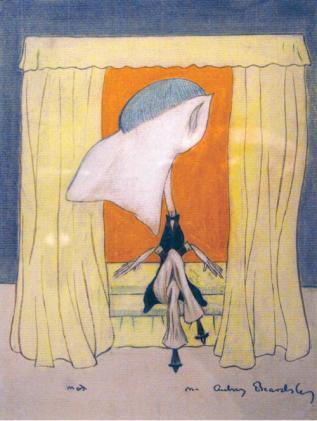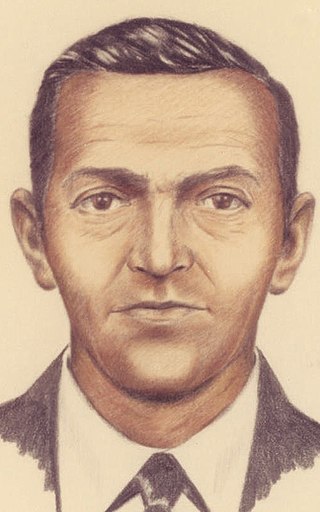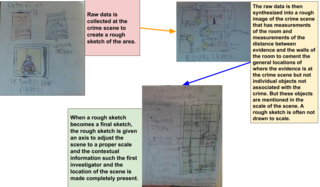Related Research Articles

The face is the front of an animal's head that features the eyes, nose and mouth, and through which animals express many of their emotions. The face is crucial for human identity, and damage such as scarring or developmental deformities may affect the psyche adversely.
Categorization is a type of cognition involving conceptual differentiation between characteristics of conscious experience, such as objects, events, or ideas. It involves the abstraction and differentiation of aspects of experience by sorting and distinguishing between groupings, through classification or typification on the basis of traits, features, similarities or other criteria that are universal to the group. Categorization is considered one of the most fundamental cognitive abilities, and it is studied particularly by psychology and cognitive linguistics.

A caricature is a rendered image showing the features of its subject in a simplified or exaggerated way through sketching, pencil strokes, or other artistic drawings. Caricatures can be either insulting or complimentary, and can serve a political purpose, be drawn solely for entertainment, or for a combination of both. Caricatures of politicians are commonly used in newspapers and news magazines as political cartoons, while caricatures of movie stars are often found in entertainment magazines.

Physiognomy or Face Reading is the practice of assessing a person's character or personality from their outer appearance—especially the face. The term can also refer to the general appearance of a person, object, or terrain without reference to its implied characteristics—as in the physiognomy of an individual plant or of a plant community.

Facial perception is an individual's understanding and interpretation of the face. Here, perception implies the presence of consciousness and hence excludes automated facial recognition systems. Although facial recognition is found in other species, this article focuses on facial perception in humans.
Similarity refers to the psychological degree of identity of two mental representations. It is fundamental to human cognition since it provides the basis for categorization of entities into kinds and for various other cognitive processes. It underpins our ability to interact with unknown entities by predicting how they will behave based on their similarity to entities we are familiar with. Research in cognitive psychology has taken a number of approaches to the concept of similarity. Each of them is related to a particular set of assumptions about knowledge representation.

A facial composite is a graphical representation of one or more eyewitnesses' memories of a face, as recorded by a composite artist. Facial composites are used mainly by police in their investigation of crimes. These images are used to reconstruct the suspect's face in hope of identifying them. Facial reconstruction can also be used in archeological studies to get a visualization of ancient mummies or human remains.
In physical attractiveness studies, averageness describes the physical beauty that results from averaging the facial features of people of the same gender and approximately the same age. The majority of averageness studies have focused on photographic overlay studies of human faces, in which images are morphed together. The term "average" is used strictly to denote the technical definition of the mathematical mean. An averaged face is not unremarkable, but is, in fact, quite good looking. Nor is it typical in the sense of common or frequently occurring in the population, though it appears familiar, and is typical in the sense that it is a good example of a face that is representative of the category of faces.
The cross-race effect is the tendency to more easily recognize faces that belong to one's own racial group, or racial groups that one has been in contact with. In social psychology, the cross-race effect is described as the "ingroup advantage," whereas in other fields, the effect can be seen as a specific form of the "ingroup advantage" since it is only applied in interracial or inter-ethnic situations. The cross-race effect is thought to contribute to difficulties in cross-race identification, as well as implicit racial bias.

Forensic art is any art used in law enforcement or legal proceedings. Forensic art is used to assist law enforcement with the visual aspects of a case, often using witness descriptions and video footage.
Eyewitness memory is a person's episodic memory for a crime or other witnessed dramatic event. Eyewitness testimony is often relied upon in the judicial system. It can also refer to an individual's memory for a face, where they are required to remember the face of their perpetrator, for example. However, the accuracy of eyewitness memories is sometimes questioned because there are many factors that can act during encoding and retrieval of the witnessed event which may adversely affect the creation and maintenance of the memory for the event. Experts have found evidence to suggest that eyewitness memory is fallible.

Chingis A. Izmailov was a Russian psychophysiologist and psychophysicist, the principal author of the spherical model of color space.
Steve Penrod is a distinguished professor of psychology at the John Jay College of Criminal Justice. His education and career have led him to become an expert in the areas of psychology and law. He has contributed heavily to the field of psychology in the area of eyewitness memory, specifically the accuracy of eyewitness identification.
Roderick Cameron Lodge Lindsay is a Canadian psychologist who studies the area of psychology and law, and focuses on eyewitness memory. In 1974, he received his bachelor's degree at the University of Toronto and in 1978 he received his master's degree from the University of Alberta. Lindsay also received his Ph. D from the University of Alberta in 1982.
Ethnic identity development includes the identity formation in an individual's self-categorization in, and psychological attachment to, (an) ethnic group(s). Ethnic identity is characterized as part of one's overarching self-concept and identification. It is distinct from the development of ethnic group identities.

Reconstructive memory is a theory of memory recall, in which the act of remembering is influenced by various other cognitive processes including perception, imagination, motivation, semantic memory and beliefs, amongst others. People view their memories as being a coherent and truthful account of episodic memory and believe that their perspective is free from an error during recall. However, the reconstructive process of memory recall is subject to distortion by other intervening cognitive functions such as individual perceptions, social influences, and world knowledge, all of which can lead to errors during reconstruction.
A neurological look at race is multifaceted. The cross-race effect has been neurologically explained by there being differences in brain processing while viewing same-race and other-race faces. There is a debate over the cause of the cross-race effect.
Emotion perception refers to the capacities and abilities of recognizing and identifying emotions in others, in addition to biological and physiological processes involved. Emotions are typically viewed as having three components: subjective experience, physical changes, and cognitive appraisal; emotion perception is the ability to make accurate decisions about another's subjective experience by interpreting their physical changes through sensory systems responsible for converting these observed changes into mental representations. The ability to perceive emotion is believed to be both innate and subject to environmental influence and is also a critical component in social interactions. How emotion is experienced and interpreted depends on how it is perceived. Likewise, how emotion is perceived is dependent on past experiences and interpretations. Emotion can be accurately perceived in humans. Emotions can be perceived visually, audibly, through smell and also through bodily sensations and this process is believed to be different from the perception of non-emotional material.
Verbal overshadowing is a phenomenon where giving a verbal description of sensory input impairs formation of memories of that input. This was first reported by Schooler and Engstler-Schooler (1990) where it was shown that the effects can be observed across multiple domains of cognition which are known to rely on non-verbal knowledge and perceptual expertise. One example of this is memory, which has been known to be influenced by language. Seminal work by Carmichael and collaborators (1932) demonstrated that when verbal labels are connected to non-verbal forms during an individual's encoding process, it could potentially bias the way those forms are reproduced. Because of this, memory performance relying on reportable aspects of memory that encode visual forms should be vulnerable to the effects of verbalization.
John Kendall Kruschke is an American psychologist and statistician known for his work in connectionist models of human learning, and in Bayesian statistical analysis. He is Provost Professor Emeritus in the Department of Psychological and Brain Sciences at Indiana University Bloomington. He won the Troland Research Award from the National Academy of Sciences in 2002.
References
- 1 2 3 4 5 6 7 8 9 10 11 Valentine, T. (1991). A unified account of the effects of distinctiveness, inversion, and race in face recognition. The Quarterly Journal of Experimental Psychology, 43(2), 161-204.
- ↑ Vitale, J., & Johnston, B., & Williams, M. (2016). The face-space duality hypothesis: a computational model. Proceedings of the 38th Annual Conference of the Cognitive Science Society.
- 1 2 3 4 5 6 7 8 9 Valentine, T., Lewis, M. B., & Hills, P. J. (2015). Face-space: A unifying concept in face recognition research. The Quarterly Journal of Experimental Psychology, (ahead-of-print), 1-24.
- ↑ Valentine, T., & Endo, M. (1992). Towards an exemplar model of face processing: The effects of race and distinctiveness. The Quarterly Journal of Experimental Psychology, 44(4), 671-703.
- ↑ Lewis, M. (2004). Face‐space‐R: Towards a unified account of face recognition. Visual Cognition, 11(1), 29-69.
- 1 2 3 4 5 Lee, K., Byatt, G., & Rhodes, G. (2000). Caricature effects, distinctiveness, and identification: Testing the face-space framework. Psychological Science, 11(5), 379–385. https://doi.org/10.1111/1467-9280.00274
- 1 2 Valentine, T. (2001). Face-space models of face recognition. . In M. J. Wenger & J. T. Townsend (Eds.), Computational, geometric, and process perspectives on facial cognition: Contexts and challenges (pp. 83–113). L. Erlbaum Associates.
- 1 2 3 Byatt, G., & Rhodes, G. (2004). Identification of own-race and other-race faces: Implications for the representation of race in face space. Psychonomic Bulletin & Review, 11(4), 735-741.
- 1 2 3 4 Davies, G. M., & Valentine, T. (2013). Facial composites: Forensic utility and psychological research. Handbook of eyewitness psychology, 2, 59-83.
- 1 2 3 4 Zarkadi, T., Wade, K. A., & Stewart, N. (2009). Creating fair lineups for suspects with distinctive features. Psychological Science, 20(12), 1448-1453.
- ↑ Wells, G. L., & Hasel, L. E. (2007). Facial composite production by eyewitnesses. Current Directions in Psychological Science, 16(1), 6-10.